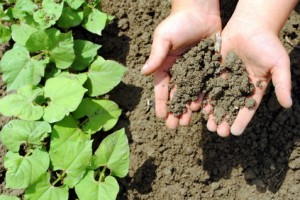 Gardens don’t have to be off-limits to children. In fact, creating a designated garden area for your kids can provide hours of fun as well as opportunities for learning. If you have limited space, allocating even a small garden bed for your child to care for can give him a sense of accomplishment and an ongoing project that changes with the seasons.
Gardens don’t have to be off-limits to children. In fact, creating a designated garden area for your kids can provide hours of fun as well as opportunities for learning. If you have limited space, allocating even a small garden bed for your child to care for can give him a sense of accomplishment and an ongoing project that changes with the seasons.
Here are some tips for creating a garden space that works for children and grown-ups alike.
Make the Garden Interactive
A garden space for kids is not something to be admired from a distance. Of course, you want the children’s gardening area to fit into your overall garden design, but the idea is for kids to experience the plants and care for them first-hand. Growing vegetables is a great way to teach kids about where food comes from, and also helps create some excitement at the dinner table when harvest time comes around. From starting seeds to transplanting and tending their growth, kids can gain a sense of responsibility while learning about the natural world.
Provide Sensory Experiences
Part of interacting with the garden is experiencing the feeling, smell and taste of the plants. All the senses can be stimulated, helping kids to understand their environment. Whether you’re growing edible plants or your garden is purely ornamental, kids will enjoy seeing and feeling the textures of different leaves, smelling the flowers on a particularly fragrant bush, and the excitement of discovering and tasting a ripe strawberry.
A few plants that are fun for kids include:
- Sunflowers – Seedlings will sprout and grow quickly, producing large flowers and edible seeds.
- Snap Peas – An early season vegetable that grows easily and can be picked and eaten right off the vine.
- Cherry Tomatoes – Can be grown in a container and are fun to pick and eat.
- Mint – Provides multiple sensory experiences – texture, taste and smell – but should be planted in a container to prevent spreading.
- Lamb’s Ears – A popular ornamental plant for children because of its thick and very soft, almost fuzzy leaves.
- Cosmos – Planting these or other easy-to-grow flowers will allow your kids to create bouquets, and they attract butterflies.
Avoiding poisonous plants is of course important, for both kids and pets, and you may want to avoid plants with thorns.
Helping your kids create labels for their garden plants, either written or with pictures, is a creative way to help them keep track of what is planted where. You can buy blank garden markers to decorate or make your own with chalkboard paint, scrap wood, laminated paper, or whatever materials will work best for your garden.
Have Fun While Learning
Gardeners know that tending plants is good for the body, mind and soul – but there’s also a certain amount of work involved. Encouraging your kids to become part of the gardening process should feel more like playtime than “doing chores.” There are endless opportunities in the garden for discovery and exploration. Eating a carrot that was just pulled from ground, digging in the soil, and watering plants are simple activities that can leave a lasting impact. Kids not only have fun doing them, but they also learn about caring for the soil, how to be patient, and how to start over when something doesn’t work out.
You can help keep your kids excited by choosing a garden bed with good growing conditions (healthy soil and adequate sunlight), plants that grow quickly and easily, and age-appropriate activities. Getting a sense of accomplishment early on will help them stay engaged with the process.
Spark Your Kids’ Imagination
Just as there is room for discovery in the garden, there is room for magic and make-believe. Perhaps your child would like to create a fairy house in her garden space by stacking rocks or twigs to resemble a tiny dwelling. You can even use a container and props to create a tiny garden that includes both plants and fairies or other imaginative characters. Small rocks become pathways, the spaces between plants become hiding places, and the plants become a forest.
By giving your child his own garden bed or container, you can help him explore his environment, build skills and confidence, and – perhaps most importantly – have fun!
